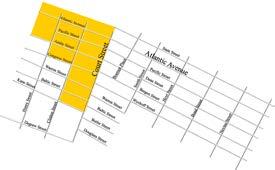SPRING 2016
Pre-Urban History
The early history of Brooklyn began with thirteen different tribes occupying Long Island. Native Americans cultivated corn on the productive soil of Boerum Hill and had easy access to the oyster beds of Gowanus Creek to the south. 1 The Canarsies, a peaceful tribe, had their primary village where Brooklyn’s Borough Hall now stands, with minor communities near the Navy Yard, Erie Basin and on the southern fringe of Boerum Hill, near Hoyt and Baltic.2 The trails uniting these settlements followed the present configurations of Fulton and Flatbush, Hoyt and Court Streets.3 The arrival of the Dutch in the early 17th century led to the ultimate downfall of the Canarsies, similarly colonization elsewhere on the East Coast reduced other Algonkian tribes. Frequent attacks from the raiding Iroquois also contributed to the demise of the Canarsies. By the 1830’s, the Canarsies were longer present in South Brooklyn. However, the Dutch population thrived. Cobble Hill dates back to the 1640’s when the Dutch Governor, Willem Kieft, granted patents for farms north of Red Hook, extending inland from the sea to the Gowanus Valley.4 In 1646, “Breuckelen” was officially recognized as a village, mainly populated with agricultural Dutch farmers and by 1660, there were 31 families residing here. As the population expanded, it maintained it’s Dutch agricultural roots. Boerum Hill can be traced back to 1645, when Jan Eversen Bout, a Dutch settler, bought the first of three land patents in the area. Jacob Stoffelson and Gerrit Wolfertsen van Couwenhoven took the two other land patents, and the three patents together comprised South Brooklyn in what is today now bounded by Fulton Avenue, Smith and Nevins Streets. The hamlet that grew up in this region, between the Wallabout and Gowanus, was known as “Brueckelen”, after a city in Holland of the same name and with much the same topographical characteristic as its American counterpart.5 The Village of Brooklyn was centered on this area to the north of the study area near the Fulton landing, while the geographic area of Cobble Hill and Boerum Hill remained mainly farmland until the early 19th century development.
“Nieuw Amsterdam wants to make Dutch its official language.” Source: The Web of Language. Accessed April 1, 2016.
On of the first Dutch to settle in the Boerum Hill area was Frederick Lubbertse who took up a grant that included most of Boerum Hill, Carroll Gardens, Cobble Hill and Red Hook. Other prominent land-owning families including the Bergen and the Van Brunt families followed the Lubbertse family to South Brooklyn. During the 18th century, the town continued to develop. In March 1704, the long Kings Highway, a portion that is today Fulton Street, was laid out from the Fulton Ferry, and linked the several villages comprising the forthcoming Kings County.
1 "From what is about Court to Nevins and between Atlantic and Dean was the Canarsie corn patch.” Butson, T. G. A Short History of Boerum Hill. New York: Long Island University, 1971 2 Ostrander, Stephen M. A history of the city of Brooklyn and Kings County. Brooklyn: by subscription, 1984. pg.11 3 Landmarks Preservation Commission. Cobble Hill Historic District Designation Report. New York City: Landmarks Preservation Commission, 1969. pg. 3 4 “The place names Red Hook, East River and Gowanus—in their Dutch spelling—all appear on the Dutch patents.” Ibid, 3. 5 Ostrander, 60
20 Early History
"Plan of the City of New York in north America: surveyed in the years 1766 & 1767" Source: Lionel Pincus and Princess Firyal Map Division, The New York Public Library. New York Public Library Digital Collections. Accessed April 1, 2016.




















